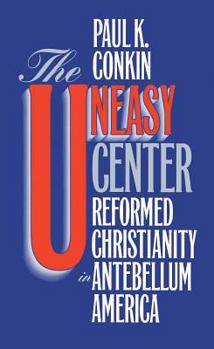Uneasy Center: Reformed Christianity in Antebellum America
Select Format
Select Condition 
Book Overview
Distinguished intellectual historian Paul Conkin offers the first comprehensive examination of mainline Protestantism in America, from its emergence in the colonial era to its rise to predominance in the early nineteenth century and the beginnings of its gradual decline in the years preceding the Civil War. He clarifies theological traditions and doctrinal arguments and includes substantive discussions of institutional development and of the order and content of worship. Conkin defines Reformed Christianity broadly, to encompass Presbyterians, Episcopalians, Congregationalists, Methodists, Calvinist Baptists, and all other denominations originating in the work of reformers other than Luther. He portrays growing unease and conflict within this center of American Protestantism before the Civil War as a result of doctrinal disputes (especially regarding salvation), scholarly and scientific challenges to evangelical Christianity, differences in institutional practices, and sectional disagreements related to the issue of slavery. Conkin grounds his study in a broad history of Western Christianity, and he integrates the South into his discussion, thereby offering a truly national perspective on the history of the Reformed tradition in America.
Format:Hardcover
Language:English
ISBN:0807821802
ISBN13:9780807821800
Release Date:February 1995
Publisher:University of North Carolina Press
Length:352 Pages
Weight:0.62 lbs.
Dimensions:1.0" x 6.1" x 9.3"
Customer Reviews
1 rating
scholarly sympathetic intro to thoughts and institutions
Published by Thriftbooks.com User , 21 years ago
It is an interesting book, it's reading part of a continuing effort at self-education on the general history of Christianity in American upto the Civil War. What is extraordinary about the book, is not the contents, but the relationship of the author to the material he covers. From the preface "My approach has been deliberately sympathetic. I wanted to understand each confession, grasp why it had such appeal to converts, comprehend its internal integrity. I have no confessional agenda. I may reflect unrecognized preferences, reveal my own taste in religions. I am fascinated with all religions and in some respects am more fascinated with the sects outside the mainstream than with the churches within it." It is my opinion that the author has been very effective in presenting just such a case to us. I end up wondering how he sustained many long nights of solitary reading in the primary religious works without a particular spiritual desire for them. I am as well amazed at how nicely he captures the nuances and pecularities of religious thought and structures and turns this exposition into an effective teaching tool. It makes a great case for the professional standards and interest in the university community to have such calibre of work from a secular professor on a topic that might be dominated by partianship.The book is scholarly, but readable and interesting, i found only chapter 5 "Outside the Evangelical Consensus", dull enough to pass over the first time through the book, mostly a result of a lack of controversial topics and a little disjointed argument. The book has a two-pronged attack on the material, both are chronological and historical. One thread is people and the history of ideas, the other is institutions and the battles of people and the forms these ideas take within them over time. He is a very good intellectual historian, these chapters are absorbing and catch you up into the long-dead battles of thought. The institutional side seems forced at times on the issue of completeness, perhaps as a textbook this is required so no reader walks away missing important details, as a casual reader i am less interested in completeness and more in intellectual influence. As a result of this i don't think that many people will be motivated simply to pick up the book and read it sequentially from front cover to back, nor is it necessary, for the chapters are written semi-independently. I found chapter 3 "Theological Foundations" and chapter 7 "Reformed Theology at Maturity: Taylor, Hodge, and Bushnell" very interesting and worthy of careful study and followup of references. The sections on Hopkinsian system bears the marks of a particular interest for the author and shows in the writing. So i would recommend a read of chapter 3 to test the waters to see if this book is for you, it being the very best of a good book.






